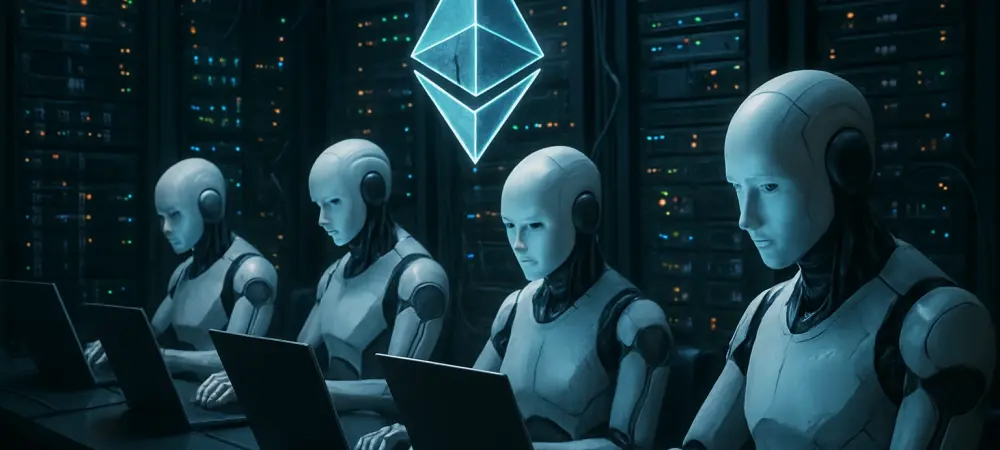Imagine a digital realm where billions of autonomous AI agents collaborate seamlessly, solving complex problems, automating industries, and redefining the very fabric of the internet as it exists in 2025. This vision of an “Internet of AI Agents” is no longer a distant concept but a tangible shift reshaping the digital world. At the heart of this transformation lies the integration of AI agents into Web3 infrastructure, moving beyond isolated systems to create a networked, collaborative ecosystem. This trend signifies a profound evolution in how technology operates, promising unprecedented efficiency and innovation. This analysis explores the current state of AI agents in Web3, highlighting growth trends, real-world applications, expert insights, future implications, and essential takeaways for understanding this groundbreaking development.
The Emergence of AI Agents in Web3
Growth Trends and Adoption Statistics
The adoption of AI agents within Web3 and enterprise sectors is accelerating at a remarkable pace. According to Gartner, by 2028, a staggering one-third of generative AI interactions will involve autonomous agents, marking a significant leap from reactive tools to proactive entities. This statistic underscores the rapid transition toward systems that independently manage tasks and collaborate across platforms.
Further supporting this momentum, a recent survey revealed that 93% of IT leaders plan to integrate AI agents into their operations within the next two years, from 2025 to 2027. This widespread intent reflects a growing recognition of AI agents’ potential to streamline processes and enhance productivity in diverse fields. The urgency to adopt these technologies is evident as businesses aim to stay competitive in a fast-evolving landscape.
Globally, research and development efforts are intensifying, with a strong focus on decentralized systems and open standards. These initiatives are pivotal in driving the evolution of AI agents, enabling them to operate within a Web3 framework that prioritizes interoperability and trust. The push for such standards is shaping a future where digital entities can interact without the constraints of proprietary boundaries.
Real-World Applications and Initiatives
Concrete examples of AI agents in action demonstrate their transformative impact on Web3 infrastructure. MIT’s Media Lab is pioneering a decentralized index for agent discovery and authentication, creating a foundational tool that allows AI entities to locate and verify each other across global networks. This project addresses a critical need for visibility in a sprawling digital ecosystem.
Another notable initiative is Cisco’s incubator project, “AGNTCY,” an open-source collaboration with partners like LangChain and LlamaIndex. This effort focuses on building an interoperable network of AI agents, facilitating seamless communication and task-sharing across different platforms. Such projects are essential for breaking down silos that currently limit AI potential in real-world scenarios.
These initiatives are laying the groundwork for Web3 by enabling cross-industry collaboration, particularly in areas like supply chain management. By connecting AI agents across diverse sectors, these efforts foster efficient workflows and innovative solutions to complex challenges. The practical applications emerging from such work highlight the tangible benefits of a networked AI ecosystem.
Expert Insights on Collaborative AI in Web3
The importance of networked AI agents in overcoming the limitations of siloed systems is a recurring theme among tech leaders and researchers. Many emphasize that current AI models, confined to specific vendor ecosystems, cannot address multifaceted challenges without collaboration. A unified network, they argue, is crucial for unlocking the full potential of autonomous agents in a decentralized environment.
Challenges such as interoperability, trust, and coordination remain significant hurdles, as noted by industry experts. Without universal standards, AI agents struggle to communicate or collaborate effectively across different frameworks. Thought leaders stress the need for a connective fabric of protocols to ensure seamless interactions, paving the way for a truly decentralized digital landscape within Web3.
The potential impact of collaborative AI is profound, with experts highlighting substantial productivity gains and the emergence of innovative services. By enabling AI agents to work together, industries can achieve scalable solutions that were previously unattainable. This perspective reinforces the transformative role of networked AI in redefining Web3 infrastructure for enhanced efficiency and creativity.
Future Implications of AI Agents in Web3
Looking ahead, the role of AI agents in Web3 envisions a digital division of labor where specialized entities tackle complex tasks through parallelization and collaboration. This structure mirrors human teamwork, with each agent focusing on niche expertise to collectively solve intricate problems. Such a model promises to revolutionize how industries approach challenges on a global scale.
Innovative projects like Coral Protocol are shaping this future by offering standardized messaging, modular coordination, and secure interactions through blockchain-based payments. These features enable AI agents to communicate universally, adapt workflows dynamically, and ensure trust via cryptographic verification. The protocol’s economic layer, using native tokens, further supports an autonomous marketplace for AI services.
While benefits like enhanced enterprise automation are clear, challenges persist in ensuring security and establishing universal standards. Addressing these issues is vital for maintaining the decentralized ethos of Web3 while scaling AI agent networks. The broader implications suggest a fundamental shift in how digital infrastructure supports industries, fostering resilience and innovation in an interconnected world.
Key Takeaways and Call to Action
Reflecting on this trend, it is evident that the shift from fragmented AI systems to a networked Internet of AI Agents marks a pivotal moment in digital evolution. The role of groundbreaking solutions like Coral Protocol proves instrumental in bridging communication and trust gaps. Meanwhile, growing enterprise adoption highlights the urgency and widespread belief in AI agents’ capabilities. The transformative journey of AI agents in rebuilding Web3 foundations stands as a testament to their capacity to revolutionize digital infrastructure. Their integration has laid a critical base for a collaborative, decentralized future. The progress made underscores a turning point in technological advancement.
Moving forward, stakeholders are encouraged to actively monitor and contribute to this evolving landscape. Engaging with emerging standards and supporting interoperable solutions can accelerate the realization of a fully networked AI ecosystem. Staying informed and involved remains essential as this trend continues to shape the trajectory of technology and collaboration.

